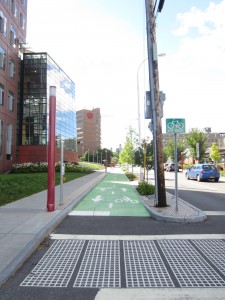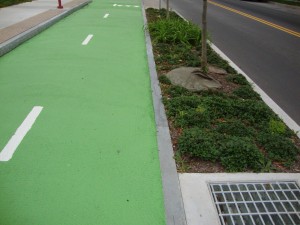The U.S. Department of Transportation’s Federal Highway Administration (FHWA) has selected the Connective Corridor as a recipient of its 2015 Environmental Excellence Award for Collaboration and Partnership.
Chosen by an independent panel, the awards are made biennially and recognize outstanding projects that incorporate environmental stewardship and advance 21st-century transportation systems. “These awards demonstrate FHWA’s support of projects that approach current and future transportation challenges with new solutions,” said U.S. Transportation Secretary Anthony Foxx.
Funded by New York State and the U.S. Department of Transportation, the Connective Corridor complete streetscape project is under FHWA administration. A small group of national FHWA projects were selected for the prestigious biennial awards in categories such as water and air quality management, cultural and historical resource protection, and multimodal transportation.
Since the program started in 1995, these biennial awards for Environmental Excellence have recognized partners, projects and processes using FHWA funding sources that make outstanding contributions that go beyond traditional transportation projects and encourage environmental stewardship and partnerships to achieve multi-faceted, environmentally sensitive transportation solutions.
The awards will be presented at the American Association of State Highway and Transportation Officials Conference on 21st Mobility to be held in Salt Lake City. Connective Corridor awardees being recognized include project engineers Barton and Loguidice, D.P.C. and CH2M, along with the New York State Department of Transportation, working with project sponsors, the City of Syracuse, Onondaga County and Syracuse University.
New York State Department of Transportation Commissioner Joan McDonald said, “The Connective Corridor project is more than just a transportation project. By linking the University area with the near east side and downtown, it opens up new development possibilities that can transform and re-energize the city of Syracuse. In addition, with its Complete Streets elements, this project will improve safety for pedestrians and bicyclists, as well as motorists.”
“Connecting Syracuse University with downtown and cleaning Onondaga Lake are two things that have been discussed for years,”said Onondaga County Executive Joanie Mahoney. “The Connective Corridor gives Syracuse University students a direct route to the heart of the city and partnering with Onondaga County’s Save the Rain program to incorporate green infrastructure in the project helps us clean the lake. It’s a great example of major stakeholders coming together to make a community better and we appreciate the recognition of this effort.”
“The Connective Corridor has been an asset to the City of Syracuse and has linked Downtown and the University in new ways, and we are proud of this collaborative achievement,” said Syracuse Mayor Stephanie A. Miner. “This project has helped make us a more vibrant and livable city. I am pleased the federal government has decided to recognize this project for its excellence and I look forward to its continued success.”
“It is wonderful that the Connective Corridor is being recognized as a case study in teamwork and environmental excellence for this community.” said Marilyn Higgins, Vice President for Community Engagement and Economic Development at Syracuse University. We are grateful to our Federal, State and Local government partners, Centro, the local arts community and the hundreds of SU students, faculty and staff who are infusing the Corridor with vitality every day.”
B&L’s Senior Vice President John Donohue noted, “Recognition of the project at the national level is certainly humbling. We are proud of this recognition, and thankful to all the sponsors and stakeholders for their participation and cooperation.”
”The Connective Corridor is the kind of modern urban infrastructure that cities of the future will need to embrace as they seek to rebuild vibrant communities that are attractive to businesses and tomorrow’s leaders” says CH2M Vice President Matthew Marko. “CH2M is proud to be part of this team and one of the key stewards of Save the Rain’s green infrastructure movement that is allowing our transportation corridors to move people – not just cars, safely and efficiently as they also improve our local water resources.”
The Connective Corridor, managed by Syracuse University’s Office of Community Engagement and Economic Development, has won numerous other design, engineering, transportation planning and public works awards. Among them are awards from the:
- American Public Works Association
- Institute of Transportation Engineers
- American Council of Engineering Companies
- U.S Department of Transportation Office of Safety Proven Highway Safety Countermeasures
- The U.S. Green Building Council’s Global Community Leadership Award, shared by Syracuse University, the City of Syracuse and Onondaga County for their unique collaboration around the Connective Corridor and sustainability initiatives.



Leave a Reply